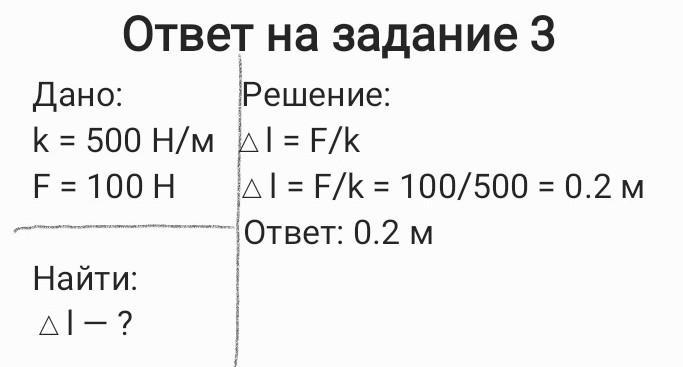Предмет: Физика,
автор: leila847
5 задание пж пжпжпж
Приложения:

Ответы
Автор ответа:
0
Ответ на задания 1-5
- 1. Какие деформации испытывают:
а) натянутая струна гитары
Деформация растяжения
б) сверло
Деформация кручения
в) Зубья пилы
Деформация изгиба
- 2. Под действием какой силы выпрямляется согнутая линейка? Чему будет равна эта сила, когда линейка полностью распрямиться?
Согнутая линейка выпрямляется под действием силы упругости (Fупр).
Когда линейка распрямится, эта сила будет равна нулю
- 3. Вычислить деформацию пружины жёсткостью 500 мН, растягиваемую двумя противоположно направленными силами по 100 Н каждая.
На фото ниже я всё расписал
- Знаком " / " обозначена дробная черта (Пример: 1/2 - в числителе 1, в знаменателе 2)
- 4. Каков коэфициент жёсткости берцовой кости, если масса человека 80 кг, а кость сжимается на 0.3 мм?
1) dx = 0,3 миллиметра = 0,0003 метра
(2)) Найдем силу тяжести (Fтяж), действующую на человека:
2) F = m*g = 80*10 = 800 Н
(3)) Тогда коэффициент жесткости будет равен:
3) k = F/dx = 800/0,0003 = 800*10^4/3 = 8*10^6/3 = 2,7*10^6 Н/м
Ответ: k = 2,7*10^6 Н/м
〘 k измеряется в [Н/м] (Ньютон/метр) 〙
〘dx - величина, на которую сжимается тело (в данном случае берцовая кость) 〙
- 5. Определите силу упругости по графику
На графике Fупр = 10 Н
Приложения:

Похожие вопросы
Предмет: Английский язык,
автор: anastasiyaivan61
Предмет: Українська мова,
автор: k97640031
Предмет: Английский язык,
автор: dastankubeev574
Предмет: Физика,
автор: bibidoskali